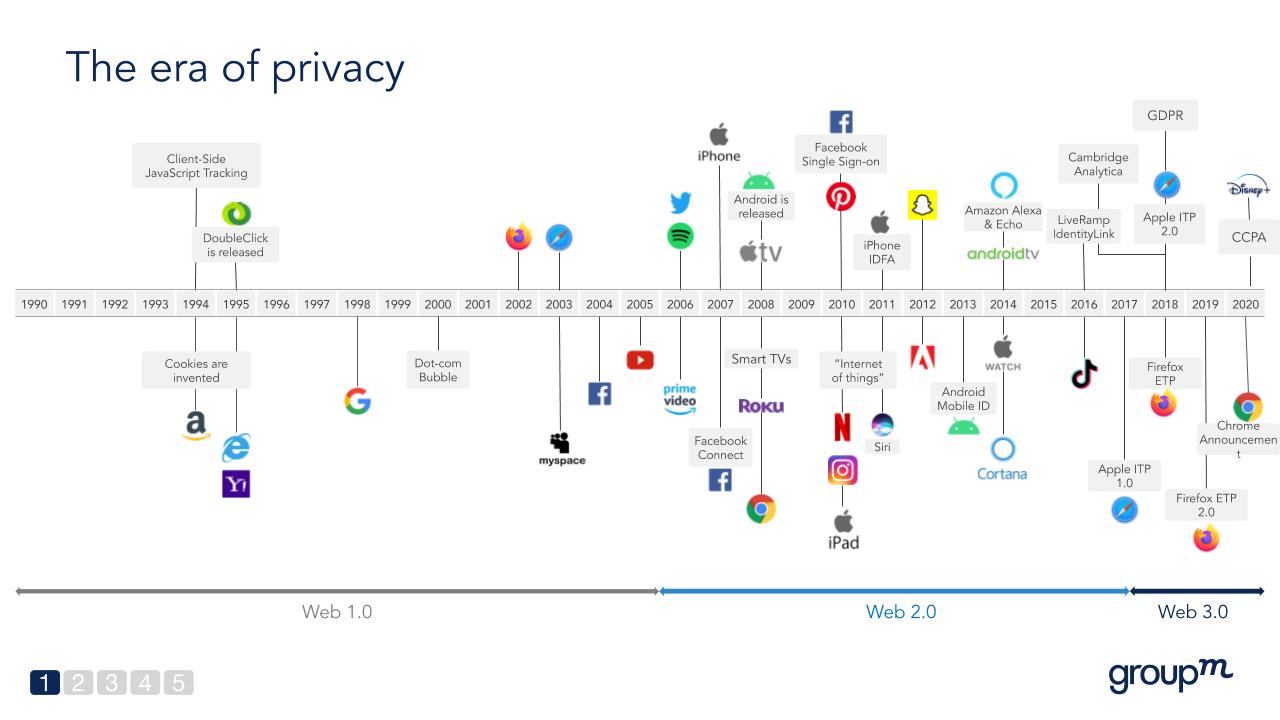Getting the Measure of a Post-Cookie World
Chris Turner - Digital Investment Director, Mediacom
How will cross-channel targeting and online measurement work in our privacy-first era? Chris Turner, MediaCom’s Digital Investment Director, explains
“You have to know the past to understand the present”, so said the American Astronomer, Carl Sagan in 1980.
Though I doubt Carl had targeting and measurement in mind, once upon a time, in a galaxy that now seems very far away, this was all relatively simple. It also does indeed help to understand the past to understand the present, and in turn, the future.
Pre 2002/03, all that existed were desktop websites, supported with a couple of leading browsers, a few ad-servers, underpinned by a handful of internet service providers - the walled gardens of their day - for GAFA(M), replace with BANTTO (BT, AOL, NTL, Telewest, Tiscali, Orange). Life was simple.
Fast forwards across the following 18 years and the rate of development and change has been exponential, as exemplified below.

Whilst the ecosystem enriched, it also became more complex to deliver seamless cross channel targeting and measurement. We saw an increase in the popularity of single entity platforms or forms of consumption that do not rely on third-party cookies, use different data sets, and the growth of an infrastructure that did not ‘talk to one another’. This ran in parallel with an increase in ad-blocking of third-party cookies, which over a period has meant that the former underpinning architecture of the digital advertising ecosystem was no longer fit for purpose.
Come web 3.0, we have moved into the era of privacy, culminating in Google Chrome’s announcement that it will be phasing out of third-party cookies - signifying the end of the infrastructure upon which digital advertising and measurement was once formerly built.
With this comes the exciting potential to innovate, with privacy at the forefront. However, it also brings huge challenges in rearchitecting how we can target messaging andmeasure activity.
But what will be the impact of these changes, and what are the potential solutions?
One of the major high impact changes from a measurement perspective will be the inability to run what are now standard and basic ad-server reports across your campaigns.
A potential workaround to this is the provision of ‘clean rooms’, in which relevant partners can share consumer data, without having access to granular, personally identifiable information, from which aggregated query results can be seen - Google’s Ads Data Hub, InfoSum, BlockGraph and Snowflake, being key players
Furthermore, as cited by the IAB Europe in its ‘Guide to the Post Third-Party Cookie Era’, there are existing techniques, which we should expect to see coming to increased prominence, such as:
-
Measuring passive exposure and respondent data
-
OTS, or specific media consumption questions, which can be used to probability model exposure from
-
Control exposure experiments
-
Advanced analytics, to model impact based on various separate data sets
-
Polling within publisher platforms
The potential impact of changes in measurement are important to understand in order to avoid moving further towards a position in which buyers can’t validate data outside of proprietary platforms - in-turn, making them unable to independently measure across platforms from the same source.
When it comes to targeting consumers, some methods will be unaffected by the demise of third-party cookies, and indeed have their position strengthened. This will be the case for logged-in platforms using declared digital identifiers, as their authenticated audiences will become gold
The App ecosystem is also in a strong position, as apps rely on a Device ID, as opposed to cookies, although Apple’s recent IDFA announcement will certainly rock the boat here. Similarly OTT and DOOH, which utilise postcodes and location.
The principal impact will be on the open web, which is heavily reliant on third-party cookies for targeting users across unaffiliated websites.
With targeting comes identity, and there will be a series of new innovations and a greater emphasis on techniques that are available currently. At a salient level, ones to be aware of, include:
-
Semantic contextual targeting
-
Consumer panels – to create modelling (look-a-likes)
-
Machine learning
- Agent based – simulations of how audiences might behave based on different variables
- Federated learning – using individual devices to host a machine learning algorithm, so the data is kept local -
Consumer Data Platforms (CPD) – Primarily focused on known customers, so first-party, to create a deterministic ID. Increasing the number of known customers, therefore being increasingly key
-
Pay/login walls for services – creating a declared identifier
-
Publisher media and data alliances – think of the likes of Project Ozone in the UK, which brings together the first-party data of some the leading publishing groups into a shared ID, creating singular segments
-
Beyond client/publisher ID, this then expands into broader identity solutions, such as those within ad tech, led by the Trade Desk Proprietary ID resolution partnership
At a broader market level, IAB Tech Lab’s initiative, Project Rearc, leads in trying to bring the industry together on building the future of digital identity and thus targeting capability, based on adherence to underpinning principles, as opposed to building technical solutions.
The role of the IAB here is key. Whilst the winding down of third-party cookies does help to protect consumer privacy, the open web advertising ecosystem is to a large degree funded via advertising which relies on said cookies. This has, in turn, resulted in breadth of choice, sustainability for smaller publishers, and albeit imperfect, a more open data and measurement infrastructure. A positive outcome from the post third-party cookie era would be the continued growth of this diverse, multifaceted web. We’ve understood the past, we understand the present, now time to ensure we go back to the future – a positive one for all….

Guide to Digital Innovation 2020
Introducing our Guide to Digital Innovation 2020. From shoppable video to gaming experiences, the new guide gives first-hand insight from 36 IAB UK members on the most innovative digital ad solutions and how brands can effectively harness them.
Written by
Chris Turner
Topics
Related content
Unlocking the Creative Potential of Virtual Gaming Worlds
Learn moreThe Rise of Short-Form Video & the Gen Z Social Revolution
Learn moreIntroducing our Guide to Digital Innovation 2020
Learn moreHow to Get Ahead of the Game - Gaming as a Media Channel
Learn more
Fast forward to 2030 with Futurescape
An in-depth exploration of the attitudes, innovations and media shifts that will shape the years ahead and redefine how we advertise by the turn of the decade



